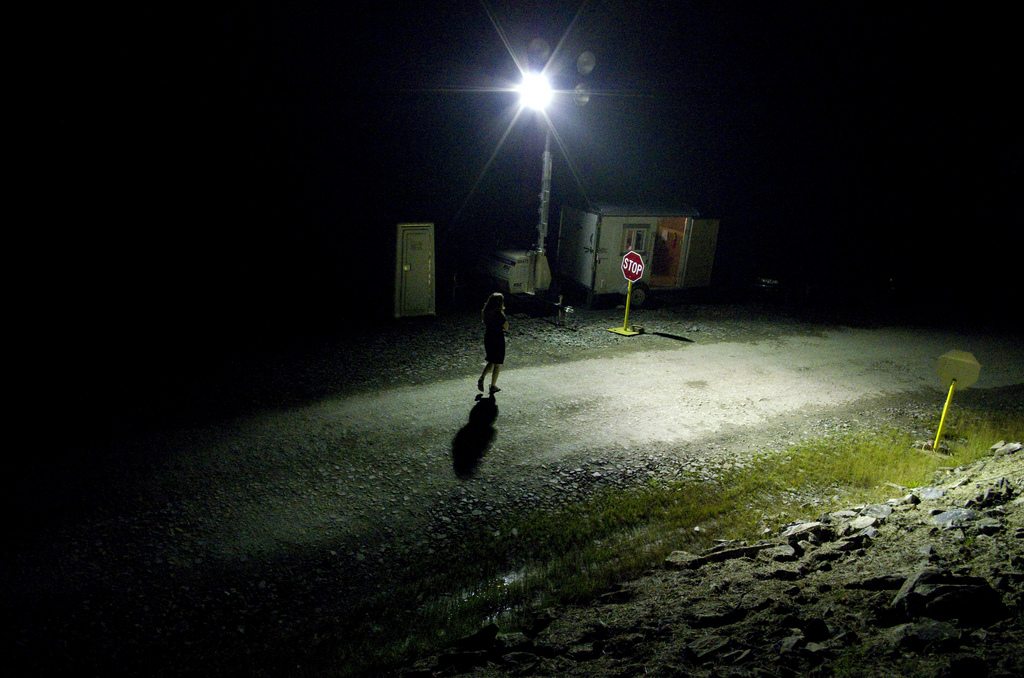Editorial

Melissa Troutman walking on a well pad in the marshlands play, near her home in Potter County while making Triple Divide. © Joshua Boaz Pribanic for Public Herald
I was moving from Virginia to Colorado in the summer of 2010 when I stopped for a visit at my family’s home, adjacent to the Susquehannock State Forest in northcentral Pennsylvania. That’s when I heard the words “Marcellus Shale” for the first time. Natural gas development had come to my native Potter County, called “God’s Country” for its pristine natural treasures and peaceful lifestyle. But this wasn’t my grandfather’s natural gas development, which has already littered public lands across the state with abandoned, leaking oil and gas wells. No, this new gas boom was bigger, deeper, and slicker.
The word around town was that we were about to have an economic renaissance. A simple Google search, however, revealed problems in other places around the country where shale gas drilling development has been occuring for years, ever since companies bought into a new kind of horizontal drilling using what is called “slickwater hydraulic fracturing” or “fracking” for short. It was all news to me, and my family, since no news source in the area was covering the incoming industrial boom diligently.
Then, I was offered a job at the local newspaper as a staff reporter. The job fell in my lap and I decided to postpone my move to the San Juan Mountains of southwestern Colorado. Had I gone to Colorado, I would have encountered natural gas development well under way and all that comes with it: more jobs and more money for some, but dirty water, air, and land for others. I stayed in PA and started covering natural gas development, hoping the same problems would not be repeated in Pennsylvania.
After only one article about natural gas, I got a phone call from Travis Windle, a representative of the Marcellus Shale Coalition in Washington, D.C. He tried to convince me that the natural gas industry was not “exempt” from the federal Safe Drinking Water Act. He said my use of the word “exempt” made it sound like the industry’s practice of fracking had previously been regulated and now was not, when in fact, fracking has never been regulated, according to him.
I took his comments to heart. I didn’t want to publish anything misleading. But after looking at my sources and at other reports again, I concluded that our discussion was purely semantic, that what had become known as the “Halliburton Loophole,” written into the Energy Policy Act of 2005 by then president Dick Cheney, was indeed an exemption.
For a while, the reports of pollution and ill health were coming from other places… other states. Then, in the fall of 2010, I met the first of many people whom had begun experiencing strange events after Marcellus wells were drilled near their home. How near? Some were only a couple hundred feet, some were a few miles. Most were reluctant to share their story with the media for fear of retaliation from the gas companies.
I began digging deeper into reports of contaminated water and air and the health effects of shale gas development in other counties as well as other parts of the country. Headaches, nosebleeds, flammable water, exploding homes, blood poisoning, unexplained skin conditions, paralyzation, neurological problems, cancer…the list went on. I read studies about air pollution in Texas and Wyoming caused by natural gas development, in some cases creating ozone and smog problems in rural areas that are worse than the smog in Los Angelos.
When I figured out how to find where drilling operations were located, I saw sites less than a mile from my family’s home.
Since the fall of 2010, more permits have been issued for other parts of the Susquehannock State Forest, on the other side of my family’s property. We have a private water well and a pond, where we keep fish and ducks for both eggs and fun, that is fed by a natural spring on state forest land. We lease access to the spring, since the state bought the land from the original owner by whom we had been given water rights.
My head spinning from everything I’d learned, I was determined to make sure my family was protected from the problems others were already facing.
I spent $400 for a water test to establish baseline results. Our water, I found, is very clean. However, to hold up in the court of law should something happen to our water, tests need to be completed within one year of a frack job. Each well, including the two near our home, can be fracked several times during the life of a well, which in some cases stretches for decades. So, in order to make sure my family’s water would be protected by the court of law in the event of contamination, I’d have to spend $400 ever year that fracking occurred around us for water tests.
My family’s home is about half a mile from the nearest active well site, but cases of contamination have occurred several miles away from gas wells. However, gas companies are presumed responsible for water contamination only within 1,000 feet of a natural gas well. Some companies, according to natural gas organizations like the Marcellus Shale Coalition, voluntarily extend this zone of liability to 2,500 feet. Where they are presumed liable, whether through state regulations or by their own ethical standards, gas companies test private drinking water sources before drilling. If problems occur they’ll perform additional tests.
My family has never been contacted about the drilling going on around them in the state forest, by either the gas companies or the Pennsylvania Bureau of Forestry. So, I contacted them.
First, the Bureau of Forestry. The District Forester’s office happens to be just a couple miles from my family’s home. They were able to tell me approximately when the wells across the road from them, and closest to my family, were going to be fracked. I got our water tests before fracking, and Penn State Extension staff tested our water after those fracking episodes as part of a research study. So far, our water is okay.
Finding out when future fracking will take place is more difficult, and getting maps of where frack jobs actually occur underground isn’t so easy either. Horizontal drilling allows companies to drill thousands of feet in any direction from a vertical well bore, which means that fracking could literally be happening right under my family’s home.
A District Forester informed me that there currently no fracking jobs scheduled at the sites near my family’s home and that the gas company usually informed his office when fracking would occur. He said he’d let me know when he knew.
I also contacted Triana Energy, a gas company preparing to drill “approximately 3-1/2 to 4 miles” from my family’s home, according to Triana’s calculations. This puts my family well outside the 2,500 foot zone of presumed liability, wherein Triana would provide free predrill testing of our water. I still wondered how far horizontal drilling would actually take place from our property? I asked Triana about it in an email I sent October 16:
There are many documented problems with residential water supplies from distances upwards of seven miles in some cases, in PA and in other parts of the country. I guess it depends on how long the horizontal wells are and where they go?
What is the projected length of the horizontals Triana plans for the site near my family’s home? Is there a map to see where they go underground, so that I can see if they will be near the natural springs in that area that we depend on for our pond and animals, and that we and other residents regularly use for drinking water? Thanks for your help!
Triana got back to me and was kind enough to send a map of where the horizontal well will be drilled, which I determined would not be near my family’s property. Because we live outside the zone of presumed liability, Triana and other gas companies do not have to notify us about when wells are fracked. In the meantime, in order to protect my family, I am at the mercy of their kindness and cooperation.
The other gas company operating near us, much closer than Triana, is Seneca Resources. Two truck drivers working for Seneca detained my partner and I against our will in Tioga State Forest in June and lied to us, saying that we were trespassing, could be arrested, and that we were not permitted to take pictures of their drill sites. We later found out that these allegations were not true, that anyone can take pictures of anything at anytime on state land. One driver went after my partner and his camera. My partner threw him off, but then the man came after me, forcibly grabbed me, wrapped his arms around me, pushed me up against our car, and tried to wrench my camera from me, hurting my sternum in the process. My partner pulled him off and, fearing we were in great danger, immediately left the scene, maneuvering the car out from between the two trucks which had blocked us in on the state road.
An investigation by Tioga State Forest’s Chief Forester found the actions of Seneca’s workers completely unacceptable and confirmed for us that we had done nothing wrong. He also suggested to the state that some policy be put into place to prevent such harassment from happening in the future. So far, we’ve heard nothing more. More importantly, Seneca has not responded to the incident, but I’ll publish more on that later.
Because of this, I assume, Seneca isn’t exactly excited to talk to me, which makes it hard to inform myself about their operations nearby and ensure the safety of my family.
Stay tuned for more as I communicate with Triana and other companies drilling for shale natural gas around my family’s home.




